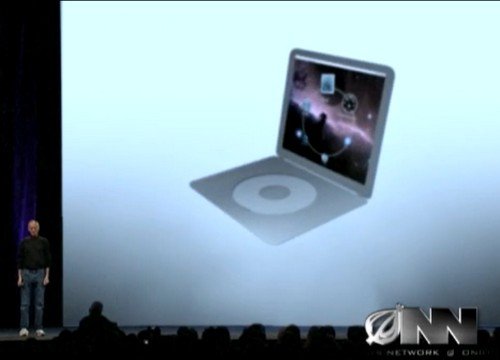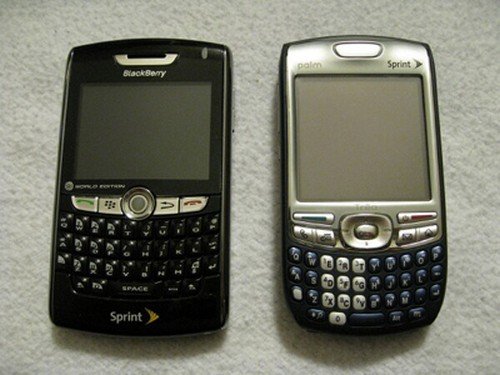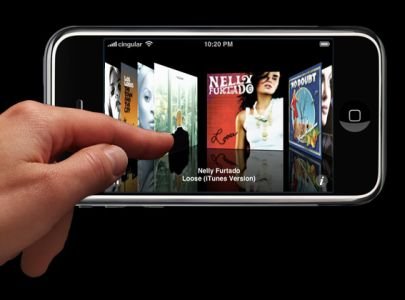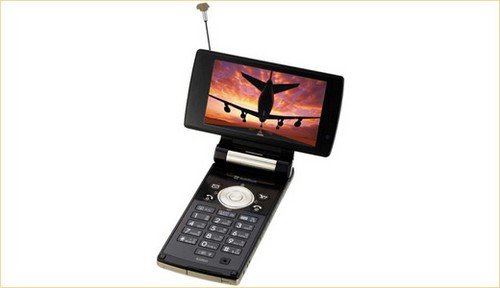|
||||||||||||||||||||||||||||||||||||||||||||||||||||||||
We got the go ahead to take this device apart. We’ve been excited to do so since we first saw it, it’s also our first Snapdragon device! Joy of Joys!
We like the Droid Incredible. It has an optical trackpad, as well as a beautifully vibrant touch-screen. Someone here at phonewreck has been using it for a few weeks. They’re away on Holidays and left the phone with us and made us promise not to tear-it-down. With that in mind we’ll probably just gently take-it-apart 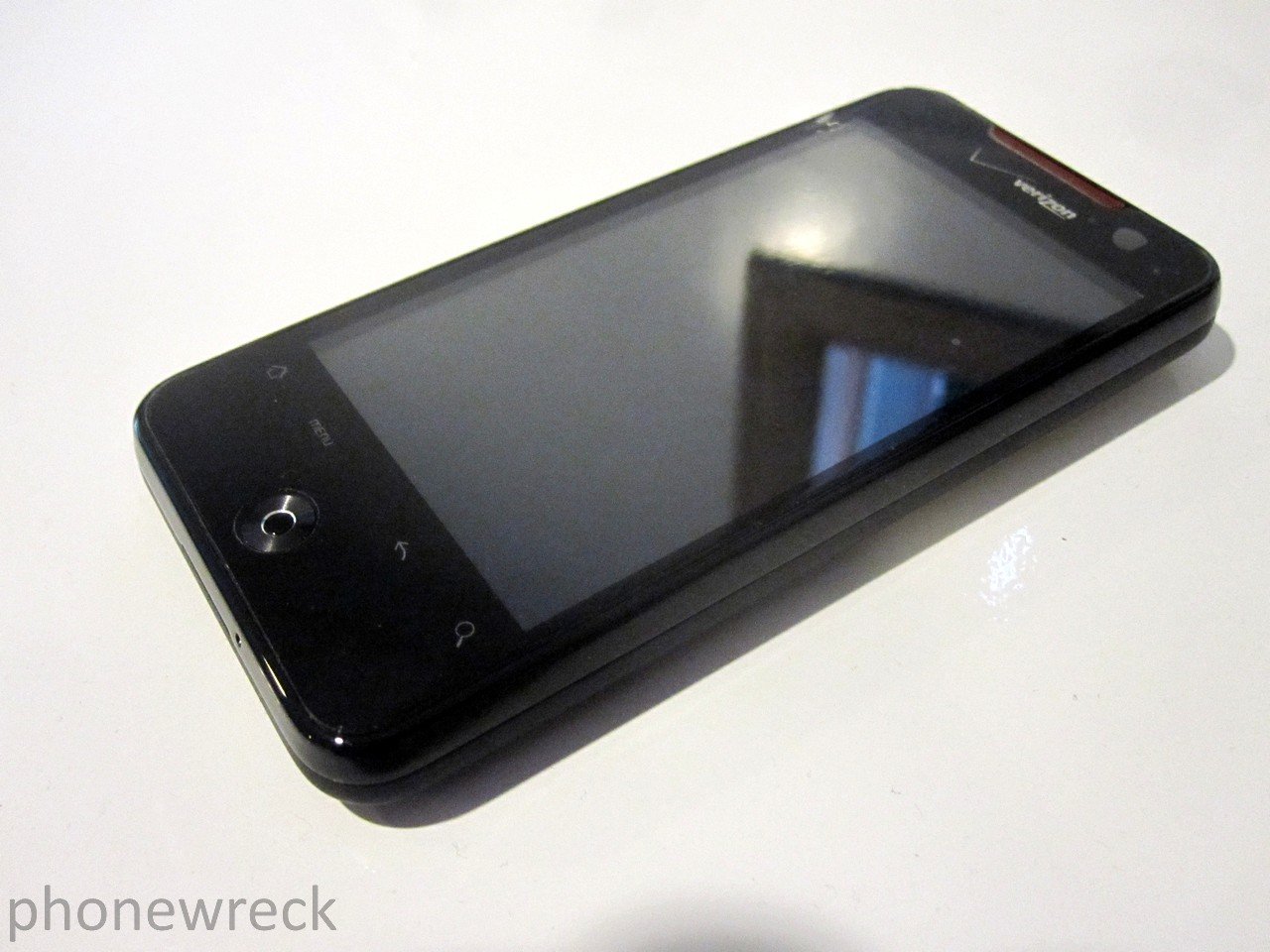 The HTC made and Verizon-loced device sports a 1GHz Snapdragon CPU, 8GB of Internal Storage, standard microSD slot and 8MP camera with dually flash and AF, and finally a 480×800 AMOLED capacitive touchscreen.
For those not in the know, this is an Android device through and through. This particular bit of hardware ships with 2.1 and HTC Sense as an OS overlay on board. We’ve heard the internals of this phone closely match other currently available devices. No matter, the Incredible is a beast of its own.
Software Stuff:
At 5,000 ft. the software and UI respond and behave similarly to other available on-market Android devices. First to discuss is HTC Sense. As you may already know, Sense blows Samsung’s Touch Wiz out of the water. This device enables 7 homescreens to store icons and widgets. HTC engineers have done a phenomenal job of enabling quality and usable widgets on this device, their own widgets offer greater functionality than Google’s options. We’ve seen some comments regarding this OS being comparable to an iPhone or even the Palm Pre. In Dr.Wrecks humble opinion, it’s a close battle but 2.1 + Sense comes in at a close 3rd.
Fortunately this device has plenty of horsepower to charge through the weight of its OS – fortunately, that doesn’t have the best battery, you won’t be blown away with multiple days of charge-free use. Unfortunately, that’s become a standard consideration in modern Smart Phone devices. Dr.Wreck will stick to his BlackBerry which can get him through a weekend away with medium to light use.
The HTC made and Verizon-loced device sports a 1GHz Snapdragon CPU, 8GB of Internal Storage, standard microSD slot and 8MP camera with dually flash and AF, and finally a 480×800 AMOLED capacitive touchscreen.
For those not in the know, this is an Android device through and through. This particular bit of hardware ships with 2.1 and HTC Sense as an OS overlay on board. We’ve heard the internals of this phone closely match other currently available devices. No matter, the Incredible is a beast of its own.
Software Stuff:
At 5,000 ft. the software and UI respond and behave similarly to other available on-market Android devices. First to discuss is HTC Sense. As you may already know, Sense blows Samsung’s Touch Wiz out of the water. This device enables 7 homescreens to store icons and widgets. HTC engineers have done a phenomenal job of enabling quality and usable widgets on this device, their own widgets offer greater functionality than Google’s options. We’ve seen some comments regarding this OS being comparable to an iPhone or even the Palm Pre. In Dr.Wrecks humble opinion, it’s a close battle but 2.1 + Sense comes in at a close 3rd.
Fortunately this device has plenty of horsepower to charge through the weight of its OS – fortunately, that doesn’t have the best battery, you won’t be blown away with multiple days of charge-free use. Unfortunately, that’s become a standard consideration in modern Smart Phone devices. Dr.Wreck will stick to his BlackBerry which can get him through a weekend away with medium to light use.
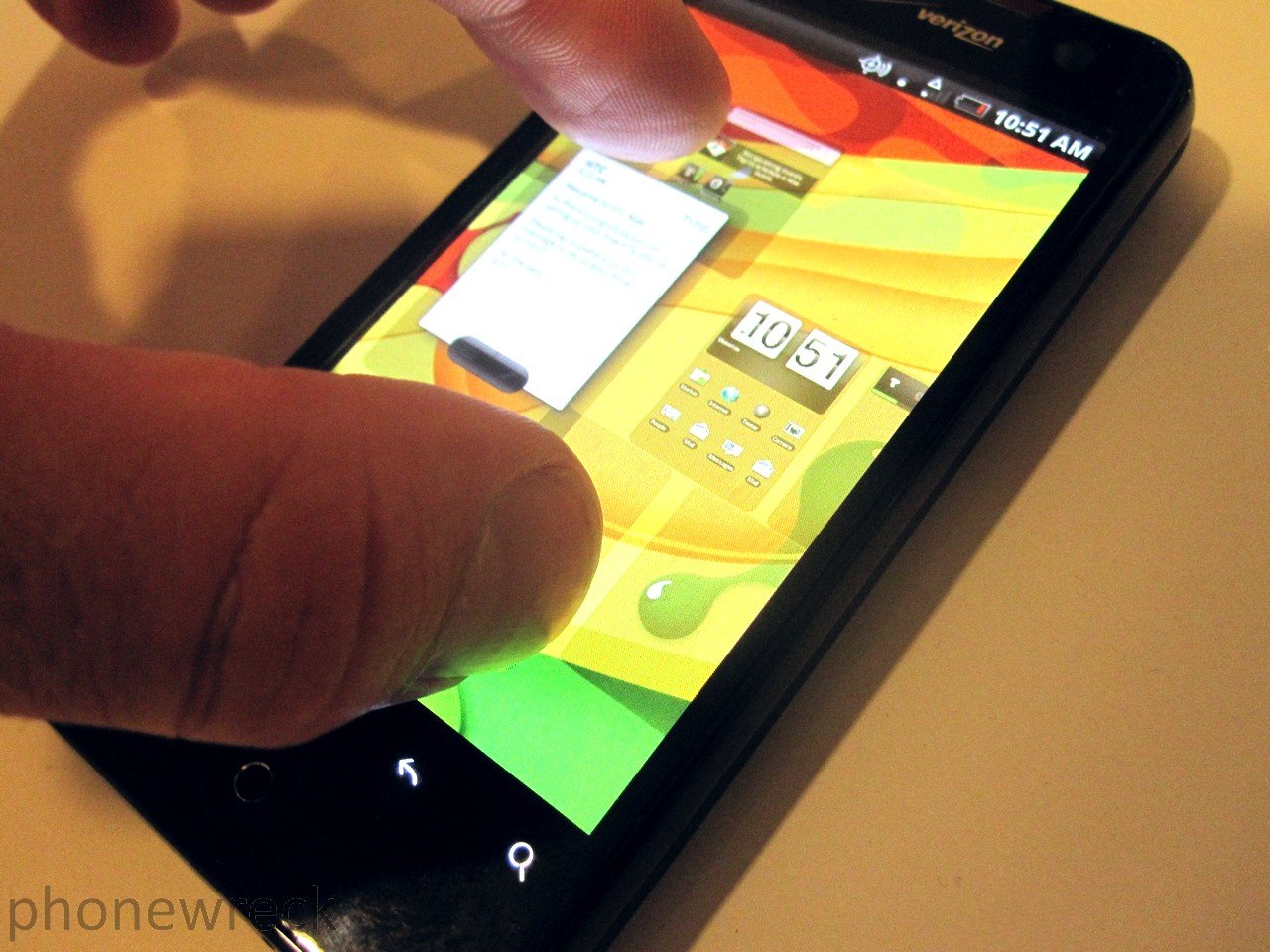 One thing you’ll notice is that Sense on this device is much more responsive than on the EVO. This is potentially due to the reduction in screen real-estate, only a teardown will really tell – too bad we can’t do one on this device
One thing you’ll notice is that Sense on this device is much more responsive than on the EVO. This is potentially due to the reduction in screen real-estate, only a teardown will really tell – too bad we can’t do one on this device 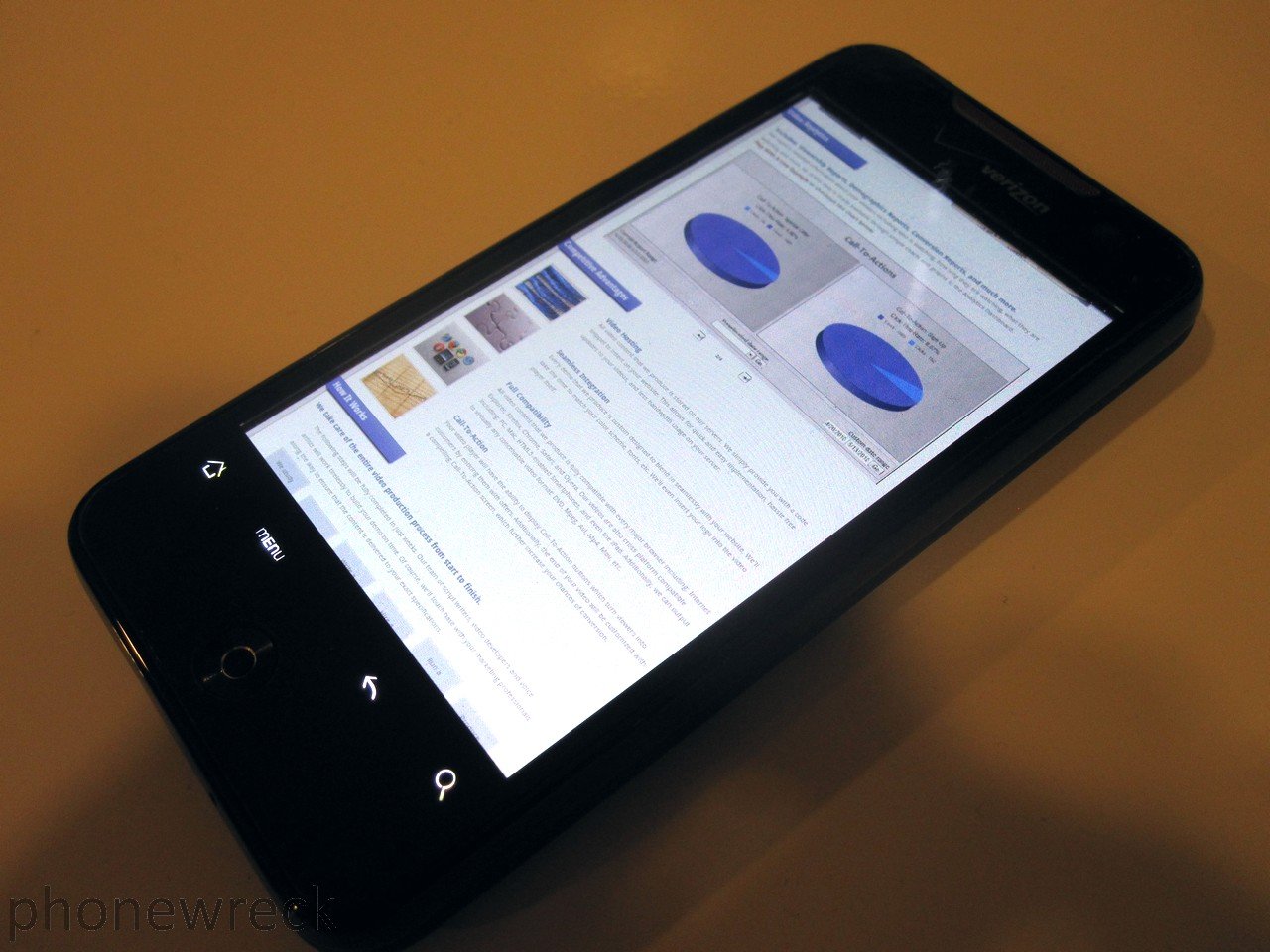 Previous Android devices have become sluggish for us over time, forcing us to enable third-party memory management software. Not the case with this device.
Hardware Stuff:
There’s no denying that this is a pretty cool looking device. The size is good, it fits easily into the palm of our hand. We also like the transformers-esque extruded shapes on the backside. Red-accents or “subtle lip-gloss” around the device give it a sporty and edgy feel without being too overdone to look like your cousin’s honda civic.
Previous Android devices have become sluggish for us over time, forcing us to enable third-party memory management software. Not the case with this device.
Hardware Stuff:
There’s no denying that this is a pretty cool looking device. The size is good, it fits easily into the palm of our hand. We also like the transformers-esque extruded shapes on the backside. Red-accents or “subtle lip-gloss” around the device give it a sporty and edgy feel without being too overdone to look like your cousin’s honda civic.
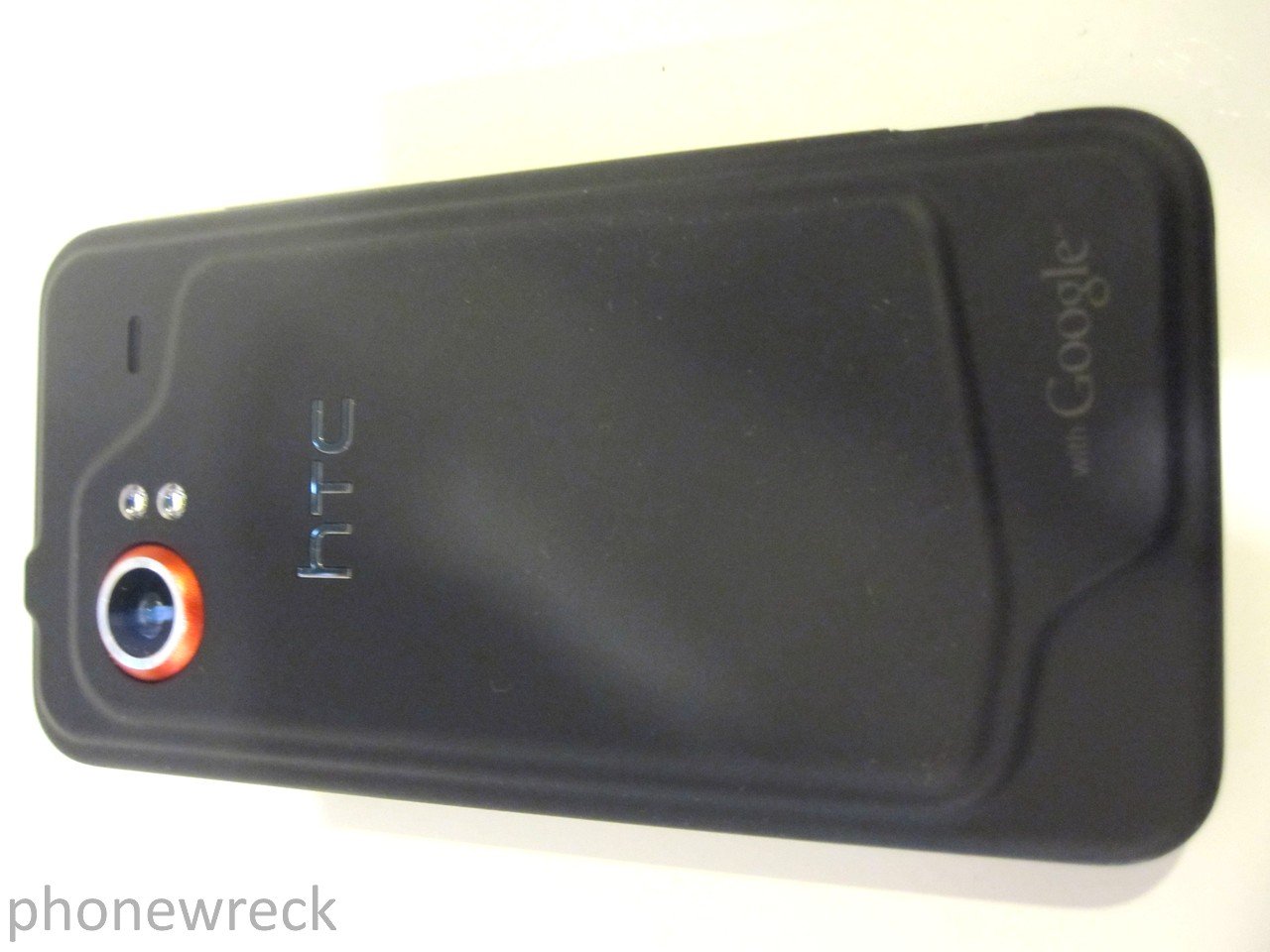 Up-front you’ll see an array of capacitive buttons and a small trackpad. You won’t use the pad much, likely only for text or URL entry. That in mind, it’s an integral piece to this devices success. We hate text navigation and editing in iOS, the trackpad is much more than a band-aid fix. Unfortunately we prefer the track-pad on the BlackBerry 9650 and 9700. It’s smoother and slightly more responsive – we can’t help but feel there’s a better overall technology available though.
Up-front you’ll see an array of capacitive buttons and a small trackpad. You won’t use the pad much, likely only for text or URL entry. That in mind, it’s an integral piece to this devices success. We hate text navigation and editing in iOS, the trackpad is much more than a band-aid fix. Unfortunately we prefer the track-pad on the BlackBerry 9650 and 9700. It’s smoother and slightly more responsive – we can’t help but feel there’s a better overall technology available though.
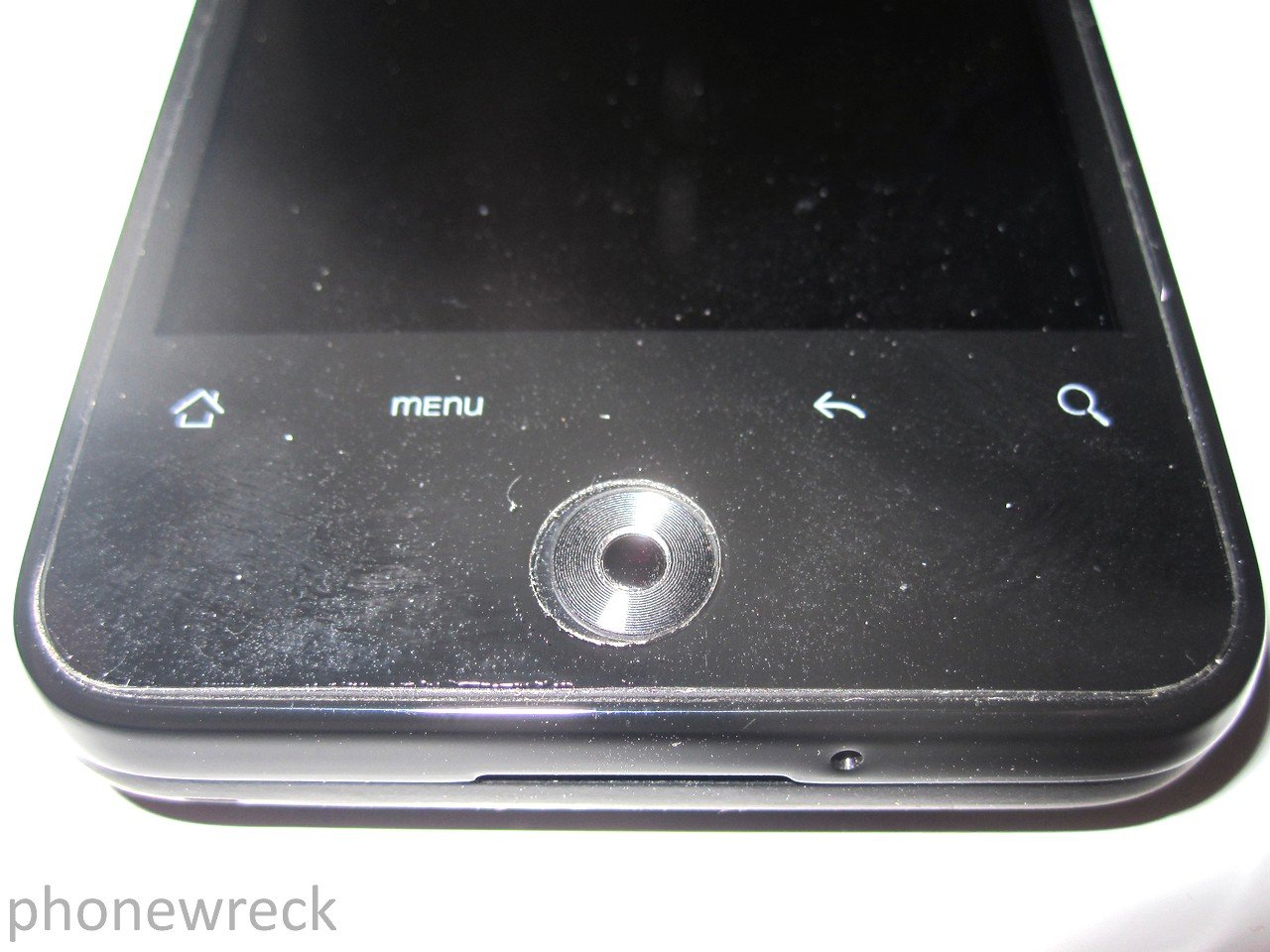 The display is great yet very Nexus One and not quite Galaxy i9000. It struggles with daylight visibility. An issue we might add, that RIM does not seem to have. How can one very different cell-phone manufacturer do such a good job with various elements that a giant like HTC continues to struggle with?
The camera is pretty solid. At a whopping 8MP it’s no real wonder. However, as with all smartphones, it has its drawbacks. For starters the response time is pretty flippin slow and there’s lots of shooting modes you’ll never use. Thankfully, you can choose 4:3 or 16:9 aspect ratio.
The display is great yet very Nexus One and not quite Galaxy i9000. It struggles with daylight visibility. An issue we might add, that RIM does not seem to have. How can one very different cell-phone manufacturer do such a good job with various elements that a giant like HTC continues to struggle with?
The camera is pretty solid. At a whopping 8MP it’s no real wonder. However, as with all smartphones, it has its drawbacks. For starters the response time is pretty flippin slow and there’s lots of shooting modes you’ll never use. Thankfully, you can choose 4:3 or 16:9 aspect ratio.
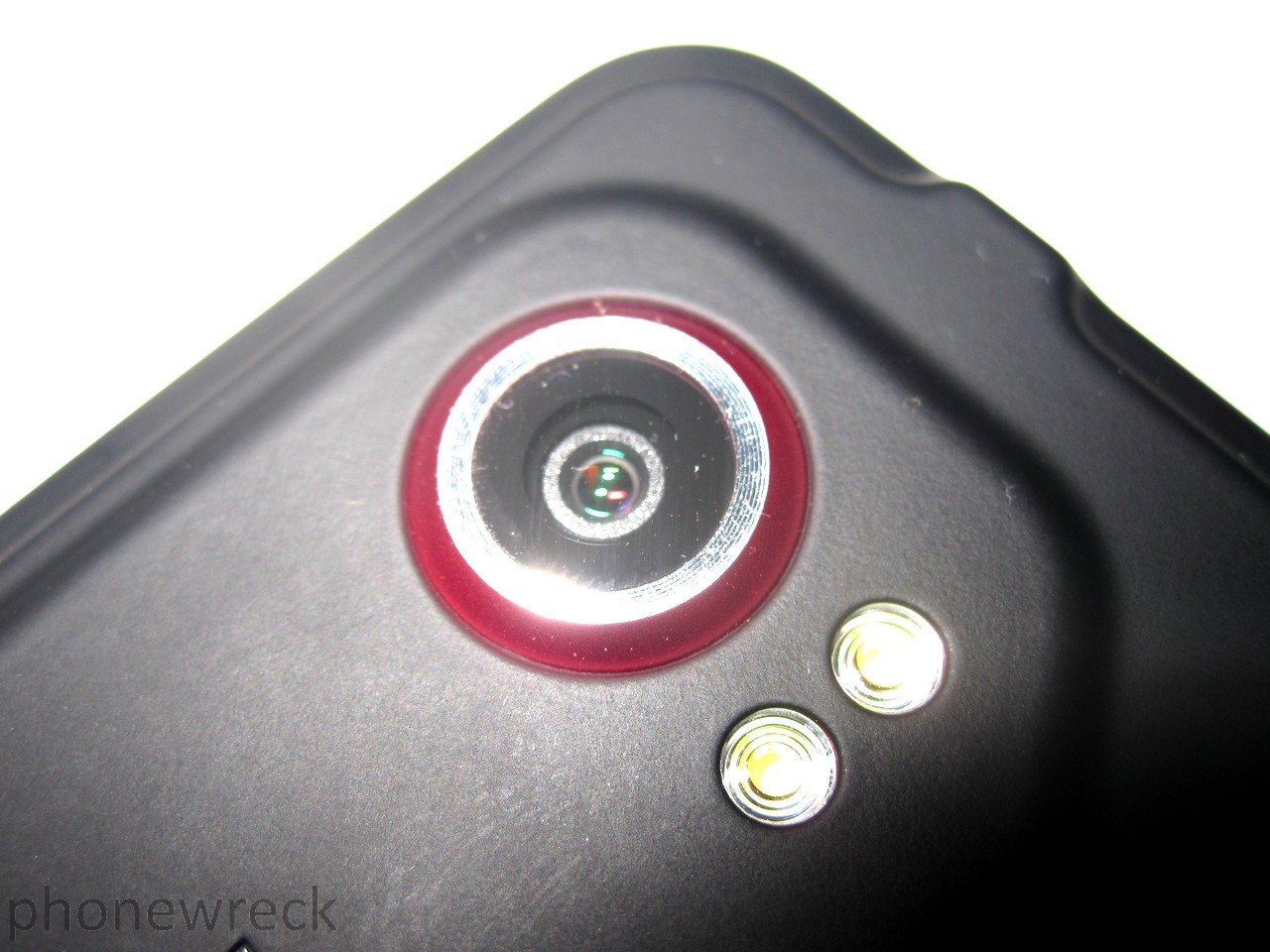 The quality is pretty good though (as can be seen in the following un-adulterated photo). Check out the detail in the tree bark. We also like that you need to press the trackpad to snap a photo. On-screen triggers are clumsy and block your view of the photo to be.
The quality is pretty good though (as can be seen in the following un-adulterated photo). Check out the detail in the tree bark. We also like that you need to press the trackpad to snap a photo. On-screen triggers are clumsy and block your view of the photo to be.
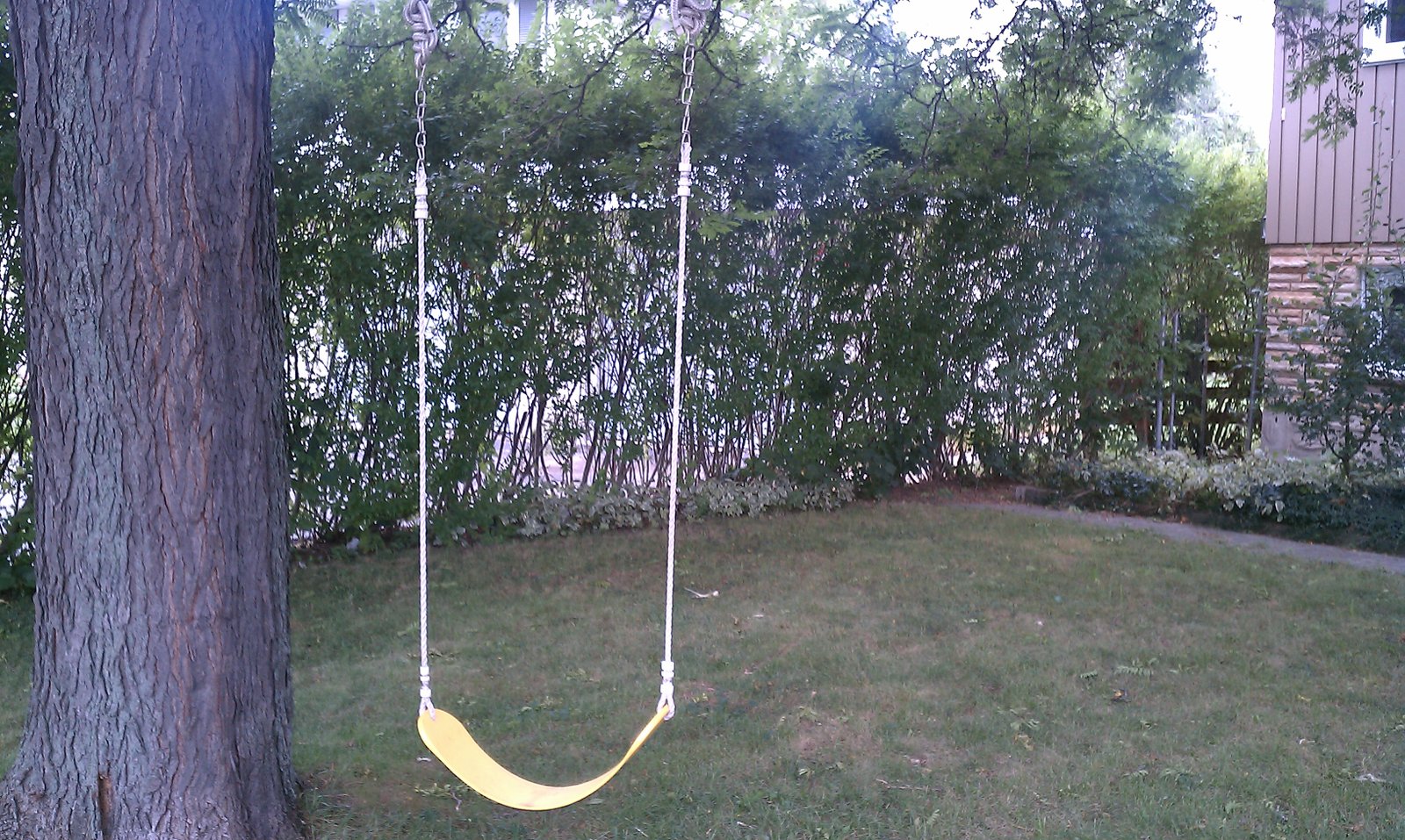 Video is another thing entirely. We won’t spend too much time on it, but this device does not offer HD. Everything under this sun does HD recording. This device has a bloody 8MP Image sensor. What’s the deal? What the heck?
Conclusion:
There’s lots to like about this phone, there’s also lots to wish were different or just a little bit better. There are better devices currently on market, but the Incredible can likely meet your demands. Will HTC support this device in the future? Probably not. Judging by the sheer volume of Android devices they pump out each quarter, the expectation will be for you to upgrade hardware before your current contract is up. Telecom woes baby.
Final Score: 7.64846879 Incredible Droids out of 10.Yesterday was a Big day for E-readers. We saw the nook drop to $149.99 (WiFi only) and $199.99 for the 3G model. The Kindle 3 was hovering around $259.99 but made a significant leap to $189.99 at the news! Keep in the mind the kindle comes packaged with 3G regardless of price-point.
Video is another thing entirely. We won’t spend too much time on it, but this device does not offer HD. Everything under this sun does HD recording. This device has a bloody 8MP Image sensor. What’s the deal? What the heck?
Conclusion:
There’s lots to like about this phone, there’s also lots to wish were different or just a little bit better. There are better devices currently on market, but the Incredible can likely meet your demands. Will HTC support this device in the future? Probably not. Judging by the sheer volume of Android devices they pump out each quarter, the expectation will be for you to upgrade hardware before your current contract is up. Telecom woes baby.
Final Score: 7.64846879 Incredible Droids out of 10.Yesterday was a Big day for E-readers. We saw the nook drop to $149.99 (WiFi only) and $199.99 for the 3G model. The Kindle 3 was hovering around $259.99 but made a significant leap to $189.99 at the news! Keep in the mind the kindle comes packaged with 3G regardless of price-point.
 This is big news, and greatly reduces the margin each manufacturer takes on the device sale.
On both devices, data is offered for free. We all know from personal experience that data isn’t cheap. We also saw from a previous teardown (Kindle 3) – that these devices are NOT cheap the build. The BOM on the Kindle 3 we took apart hovers around ~$200.
How is Amazon going to make money you may ask! Book sales of course! The Kindle is a promising platform, Apps will definitely extend the Hardware Value proposition in the near future. Not to mention seamless integration with your BlackBerry, iPhone, Desktop and iPad. Amazon has really built an interesting business model and content network – if Dr.Wreck was to jump on an e-reader bandwagon it would definitely be Kindle’s.
Competition from high-cost, multi-purpose devices will definitely drive the cost of e-readers down over the next year or so. At phonewreck, we feel it’s only a matter of time before these things are offered for a few bucks, or the purchase of 10-20 e-books. Wouldn’t that be nice?
You may still think, “$200 for an e-reader is way too much, I’d rather go for an iPad” – Dr.Wreck’s opinion? You probably wouldn’t take the iPad to the beach.That’s right – you can now have 128GB of storage in a 17 x 22 x 1.7 mm footprint – brought to you by Toshiba. I can’t help but think this device will have a massive play in the larger devices we’re seeing come to light (See Tablet’s, MIDs, etc.)
This is big news, and greatly reduces the margin each manufacturer takes on the device sale.
On both devices, data is offered for free. We all know from personal experience that data isn’t cheap. We also saw from a previous teardown (Kindle 3) – that these devices are NOT cheap the build. The BOM on the Kindle 3 we took apart hovers around ~$200.
How is Amazon going to make money you may ask! Book sales of course! The Kindle is a promising platform, Apps will definitely extend the Hardware Value proposition in the near future. Not to mention seamless integration with your BlackBerry, iPhone, Desktop and iPad. Amazon has really built an interesting business model and content network – if Dr.Wreck was to jump on an e-reader bandwagon it would definitely be Kindle’s.
Competition from high-cost, multi-purpose devices will definitely drive the cost of e-readers down over the next year or so. At phonewreck, we feel it’s only a matter of time before these things are offered for a few bucks, or the purchase of 10-20 e-books. Wouldn’t that be nice?
You may still think, “$200 for an e-reader is way too much, I’d rather go for an iPad” – Dr.Wreck’s opinion? You probably wouldn’t take the iPad to the beach.That’s right – you can now have 128GB of storage in a 17 x 22 x 1.7 mm footprint – brought to you by Toshiba. I can’t help but think this device will have a massive play in the larger devices we’re seeing come to light (See Tablet’s, MIDs, etc.)
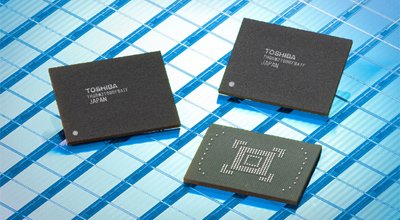 Technical Specifications:
The device is built on a new 32nm (opposed the current, 45nm standard) process, and is a combination of 16, 64Gb (8GB) NAND chips. 128GB is enough for roughly 16 hours of h.264 HD (720p) video.
No reports are currently available regarding read and write speed. You can be rest assured though, if they’ll be inside of any consumer electronic device, you won’t have issues streaming media off of it. The bottleneck might come from side-loading you’re offline-content – that remains to be seen.
The fastest integrated memory platform we’ve seen transfers at ~15MB/s (BlackBerry Bold) and that with the assistance of an external controller that effectively bypasses the devices processor core and the sometimes slow, multi-tasked transaction times.
One thing is for certain, Memory has come a long way. 128GB back in Dr.Wreck’s day would fill the Hospital he’s writing this from.
Technical Specifications:
The device is built on a new 32nm (opposed the current, 45nm standard) process, and is a combination of 16, 64Gb (8GB) NAND chips. 128GB is enough for roughly 16 hours of h.264 HD (720p) video.
No reports are currently available regarding read and write speed. You can be rest assured though, if they’ll be inside of any consumer electronic device, you won’t have issues streaming media off of it. The bottleneck might come from side-loading you’re offline-content – that remains to be seen.
The fastest integrated memory platform we’ve seen transfers at ~15MB/s (BlackBerry Bold) and that with the assistance of an external controller that effectively bypasses the devices processor core and the sometimes slow, multi-tasked transaction times.
One thing is for certain, Memory has come a long way. 128GB back in Dr.Wreck’s day would fill the Hospital he’s writing this from.
 5MB of data ~50 years agoLast week, we saw a report on cnet making claims that Apple’s iPhone 4 is powered by the same device as the Samsung Wave S8500. The renowned A4 chip is manufactured by Samsung – it makes sense that it might appear in a Samsung device.
5MB of data ~50 years agoLast week, we saw a report on cnet making claims that Apple’s iPhone 4 is powered by the same device as the Samsung Wave S8500. The renowned A4 chip is manufactured by Samsung – it makes sense that it might appear in a Samsung device.
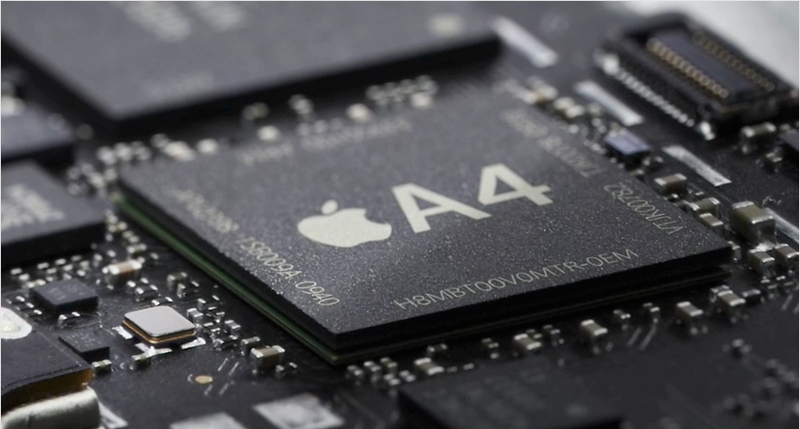 What many North Americans don’t know is that Samsung is a massive company – much larger than they might think. Samsung plays in semiconductor design, manufacturing, consumer electronics, appliances, and even automotive (i.e., They make cars). From personal experience, the various divisions have difficulty working together. The concept of a Samsung device having a Samsung core is slightly less likely than you probably thought.
R&D costs on a chip such as the A4 are bound to be quite high. Have you ever seen a chip that you weren’t able to ID on Samsung’s website? Chances are it has proprietary claims – much like “Apple’s A4”.
Well, today Dr. Wreck has news for you – semiconductor manufacturers often resell or repackage bare die in an effort to extend a device’s life-expectancy or even functional base. That means you might find yourself purchasing a crippled or often repackaged device for your next design application. This is often done by rotating the die 90 degrees inside of the package – which modifies the pin-out.
What is the device actually called? The S5PC110A01. It’s no wonder Apple, the king of branding in all things electronic, decided on something simple and sexy like the A4. This news is really no surprise – that said, the iPhone is about the only smartphone anyone should really consider building proprietary devices for (sales volumes are high enough to support R&D and tapeout).
Technical Specifications at a glance:
What many North Americans don’t know is that Samsung is a massive company – much larger than they might think. Samsung plays in semiconductor design, manufacturing, consumer electronics, appliances, and even automotive (i.e., They make cars). From personal experience, the various divisions have difficulty working together. The concept of a Samsung device having a Samsung core is slightly less likely than you probably thought.
R&D costs on a chip such as the A4 are bound to be quite high. Have you ever seen a chip that you weren’t able to ID on Samsung’s website? Chances are it has proprietary claims – much like “Apple’s A4”.
Well, today Dr. Wreck has news for you – semiconductor manufacturers often resell or repackage bare die in an effort to extend a device’s life-expectancy or even functional base. That means you might find yourself purchasing a crippled or often repackaged device for your next design application. This is often done by rotating the die 90 degrees inside of the package – which modifies the pin-out.
What is the device actually called? The S5PC110A01. It’s no wonder Apple, the king of branding in all things electronic, decided on something simple and sexy like the A4. This news is really no surprise – that said, the iPhone is about the only smartphone anyone should really consider building proprietary devices for (sales volumes are high enough to support R&D and tapeout).
Technical Specifications at a glance:
We apologize for the hiatus on posts, but we’ve been running into a few technical difficulties. Needless to say, we’re hopefully back in full force, with another analytical post! In State of the Industry we take a step back from the typical archaic product cycles of the mobile industry and focus our attention on one particular aspect of the industry. In this episode, we target the media aspect. Pictures, music, videos, movies, the whole shebang. We discuss the entertainment focus versus the enterprise focus, and we discuss consumer needs versus the technical limitations. We discuss what to look for in the future, and we discuss it in style. More mindful media madness momentarily. Previous State of Media Media has become an essential (and obvious) part of the handset market. It is becoming rare that a cellphone doesn’t have some sort of music playback functionality, and even more rare to come without a camera. Back in the day, cellphones were split between a barebones phone, media-centric phones, and enterprise phones. BlackBerry devices came out with specific lines (i.e. 8800) to address the sans-camera enterprise market. Heck, back then, it was scary if someone walked into a bathroom with a cellphone equipped with a camera.
[Image Courtesy: CrackBerry] During those times, the differences between functionality from handset maker to handset maker was quite drastic. RIM held onto its enterprise market with the fastest, most secure, and most reliable e-mail service. Palm fought back with its strengths in 3rd-party applications. HTC and Windows Mobile tried to bring “mobile computing” in the truest sense of the word, to the smartphone industry. In the midst of the enterprise battles, came Motorola, Sony Ericsson, LG and Samsung, battling on the low-end and music forefront. And with a cellphone for nearly every demographic, Nokia came out with guns and cannons blazing. Current State of Media With a sigh of annoyance, the overused and unfortunate word “convergence” comes into play. The Engineers reading this have probably skipped to the more technical sections by now, but it must be stated. The North American market (for the most part) has converged to handling everything without a sweat. In fact, the arguments of yesteryear about music playback versus e-mail, have turned into virtual keyboard versus physical keyboard versus hybrid attempts. As such, functionality arguments have turned into a focus on usability and enhancing the user-experience. With statistics like these, it’s difficult to argue that this is the case.
With media being integrated and assumed, the spotlight turns to implementation. It’s arguable, with iTunes being so well integrated and a history of industry-changing music players, that the iPhone presents itself as one of the best phones for music and general media capabilities. RIM with no less of a media player, also recently announced its intentions to play in the music space. HTC/T-Mobile/Google ventured in with Amazon MP3 integration, and it can only be assumed that Palm has something up its sleeves. With contenders like these, it’s no wonder the PMP market has really died. Luckily for us gadget freaks, companies like Cowon continue to impress with amazing audio-centric players like the S9. Of course, music represents only a portion of the media umbrella. Video playback is a whole different ball game. Technical challenges arise such as codec and format support, processor and RAM resource use, ability to push more pixels, and network and handshaking challenges for streaming video. Of course, the computing power required for graphical-intensive applications is starting to become available with platforms such as NVIDIA’s Tegra platform and Qualcomm’s possible-vaporware, Snapdragon. Traditionally, many of the companies, such as RIM, have opted for single processors solutions, but its possible that this is no longer working. With many of the core functions like GPS, audio, and graphical support being integrated into single processor solutions, these do-it-all processors could struggle depending on how capable the devices need to be at multi-tasking. Perhaps video computing still requires a discrete solutions, such as is currently the case with higher-end laptops. Companies like Apple have opted for graphical accelerators from Imagination Technologies, while other devices like Nokia’s N-Series and the upcoming Palm Pre use Texas Instrument’s OMAP platform. Playing video is just one of the current problems. Storage has always lent itself to problems. If high-definition videos come into play, say, with Tegra’s platform, it’s very possible that a traditional microSD card or internal storage will pose limitations. Transferring high-density files like these are another problem. Currently, sideloading and syncing with phones are quite slow (with the exception of most BlackBerry devices). Solutions are available, such as Cypress’s USB controllers, but perhaps companies need to take a stab at USB 3.0 integration in the near future. Assuming there are controllers and memory types to handle the bandwidth, with USB 3.0, it’s possible that transferring files will not pose a problem for another decade — but these companies really need to get on that.
Finally, the last aspect, pictures. Pictures are really a bore to talk about, but what is interesting is the camera integration in handsets. LG, Samsung, and Sony Ericsson have really stepped up recently. Phones like the Samsung Pixon, LG’s many 8MP entries, and even Sony Ericsson’s Cyber-shots, now have face-detection technology, image stabilization, and some pretty impressive functions. However, one of the main hassles with cameraphones is its inefficiency. They’re slow to access, slow to snap, and a hassle to view. Night shots are grainy, continuous shots are slow, and shooting video in HD is a whole other story. In essence, the hindrances here lie in processing power and lens technology. Phones with slimmer form factors don’t have the space for processors like Canon’s DIGIC III, let alone optical zooming capabilities. Integrated solutions are becoming the fad with manufacturers nowadays, so perhaps there is really no space for an amazing cameraphone. We do hope that they continue to search for a solution though. Important Side Notes North America is an awkward market, and we do believe it’s suffering because of its uniqueness. Europe and Japan love to integrate network-intensive features like DVB-Tuners, live TV, video conferencing, etc. Fortunately for the sake of carriers here, this isn’t the case. The geographical sparseness in the States, not to mention Canada, presents itself with the technical problem of putting up enough towers. Perhaps the 35% market share of the global music industry attests to what we North Americans look for.
Gaming is another industry that’s really booming, even in the midst of the economic conditions. Perhaps companies need to take another look at solutions like, well, a PSP Phone. One of the interesting stories is how touch sensing capabilities got hold of the gaming industry with consoles like the DS. This inherently, went to the advantage of Apple, as the iPhone now proves to be one of the strongest contenders for mobile gaming. Conclusion Handsets have really become a “console” for media entertainment. Akin to the DS and PSP of gaming consoles, what was previously left for the living room, has now been made available for users, wherever they are. Functionality and to a degree, usability, has already reached a plateau of “innovative use”. For now, the difference lies in implementation, content distribution (preferably DRM-less, although that’s a separate topic in and of itself), and the upcoming computing/processing battle for graphical power.
In fact, much of what is happening in the handset market, mimics the gaming market. The gaming industry went through a battle of controls, processing and graphical power, content distribution, and innovation. Perhaps in a different order, and perhaps with different companies, but hey, no model is perfect. The iPhone 3G is a multimedia phone developed by Apple Inc. It is the 3G-capable successor to the iPhone 2GContentsProduct Features & SpecificationsTechnical Specifications
Media Support
Bill of Materials
References
BlackBerry Bold ReviewRIM delayed its entrance into the 3G market as long as it could, before introducing its new flagship. In a sense, I’m very glad this happened, because the Bold was a great phone to review (and teardown!). Although launching through AT&T was very sketchy due to firmware issues, they’ve gotten many of the issues fleshed out on its BlackBerry OS 4.6. Greats The Bold works beautifully as your traditional BlackBerry. Any users stepping up from the Curve or the 8800 should find yourselves totally at home, with tons of extra features at your disposal. First, the Bold sports one of the most jaw-dropping screens. When you first turn the device on, the glaring Rogers background stares you right in the face, and its an awesome experience. It’s got a great contrast ratio coupled with some high pixel density action (HVGA on a 2.65″ screen). Movies and video clips look great on it. Sound is even more impressive. The Bold is single handedly the best sounding (and loudest) device on the market today. This, coupled with a really great screen, give the Bold a really strong media playback experience. The actual player is simple to use, with looks akin to Windows Media Player, and works as it should. Performance on this machine is also top notch. Using Marvell’s Hermon Processor running at a speedy 624MHz, it chews down on any of the applications you want running. Getting into menus and applications are lightning fast, which works particularly well with its trackball navigating device. Sideloading music and videos on this phone was lightning quick as well. A 700MB movie file was transferred in 48 seconds, making for a speedy 14.6MBps transfer speed. Great for packing in movies on your MicroSD card on the go. I don’t even have to talk about the e-mailing and texting experiences, because that’s RIM’s spotlight, that at this point, will be really hard for them to screw up. Everything was quick and easy to use, which brings us to our last Great: the QWERTY keyboard. It’s freakishly fast. We’re heavy BlackBerry users, and we’d venture so far as to say this is on par with the Curve (which we thought to be the benchmark). Those dimples work fantastically for our fingers. Middle Class Features With Americans always focusing on the middle class, we thought we’d title this accordingly. The first middle class feature of the Bold is its browsing experience. Browsing on 3G data was a long awaited feature on BlackBerrys, and we conclude that, while it’s amazing for a BlackBerry, it doesn’t nearly match its competitors performance. When compared to the iPhone and the G1, iPhone’s Safari implementation consistently boasted double the speeds of the Bold when viewing heavy websites and pages, and G1′s Chrome-Lite-ish ran through at around 1.5 times faster. RIM really needs to revamp their browser. It’s good, but its not great — and for their flagship, these things need to be great. Gripes The Bold is unfortunately a little on the big side. When compared to other consumer-oriented phones, it’s very chunky and fills the pockets pretty quickly. Holsterers will be fine, but those of us not wanting to venture into the business-class look, will find the extra bulk a little annoying. The leather backing and the chrome sides are also questionable design choices. If it was implemented a little better, we’d totally dig that. Unfortunately, the fake leather coupled with cheap feeling sides, leave a little to be desired for a phone that just dented your wallet. Conclusion: The Bold is a pleasure to use. It’s fast, it’s efficient, and it’s even friendly to you. Take heart, young QWERTY padawans, you’ll be enjoying RIM’s latest 3G device. Just keep those speakers blasting. We wanna hear ya. BlackBerry Bold: 9/10BlackBerry Bold TeardownHere is where we get down to the nitty grittys of the device. The Bold was as pleasurable to teardown as it was to review. Opening it up was simple, but the Bold gave us trouble when it let us look at its hallowed PCB. It’s a complicated mess there. ICs seem to be relatively organized, but there are so many pieces to this puzzle, that it was a daunting task to build up the BOM and the block diagrams. Fortunately for you, we love doing this stuff. So we present to you, the BlackBerry Bold Block Diagram.
|
||||||||||||||||||||||||||||||||||||||||||||||||||||||||
|
Copyright © 2010 phoneWreck - All Rights Reserved |
||||||||||||||||||||||||||||||||||||||||||||||||||||||||

